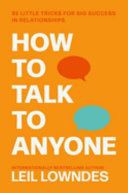

First impressions are crucial in any interaction, as they set the tone for how others perceive you. The book emphasizes that within the first few seconds of meeting someone, they form an opinion about you based on your appearance, body language, and initial words. It suggests techniques to ensure that your first impression is positive, such as dressing appropriately, maintaining good posture, and using a firm handshake. The author also discusses the psychological principles behind first impressions, explaining how they can influence the course of a conversation and the relationship that follows. By being aware of these factors, individuals can strategically present themselves in a way that fosters connection and trust from the outset.
Continue readingNon-verbal communication plays a significant role in how messages are conveyed and interpreted. The book teaches readers about the nuances of body language, including facial expressions, gestures, and eye contact. It highlights how positive body language can enhance communication by making you appear more approachable and engaged. For instance, maintaining eye contact can indicate confidence and interest, while open body posture can make you seem more welcoming. Conversely, negative body language, such as crossed arms or lack of eye contact, can create barriers in communication. By being aware of your own body language and reading that of others, you can improve your conversational skills and create more meaningful interactions.
Continue readingEffective communication is not just about speaking; it also involves listening. The book underscores the importance of active listening, which is the practice of fully concentrating on what the speaker is saying rather than simply waiting for your turn to talk. The author provides strategies for enhancing listening skills, such as nodding, paraphrasing, and asking follow-up questions. These techniques not only show the speaker that you value their words but also help you to better understand their perspective. By mastering active listening, you can foster deeper connections with others and create a more engaging conversational atmosphere.
Continue readingOne of the most effective ways to build rapport with someone is to find common interests or experiences. The book suggests strategies for identifying shared topics that can serve as a foundation for conversation. This could include discussing mutual hobbies, experiences, or opinions on current events. By highlighting similarities, you can create a sense of camaraderie and make the conversation more enjoyable for both parties. The author also discusses the psychological benefits of finding common ground, as it can reduce feelings of anxiety and promote a sense of belonging in social situations.
Continue readingSmall talk is often viewed as superficial, but it serves an important purpose in social interactions. The book provides tips for engaging in small talk effectively, including how to initiate conversations, keep them flowing, and gracefully exit them. It emphasizes the value of asking open-ended questions that encourage elaboration and sharing. The author also addresses common pitfalls in small talk, such as dominating the conversation or discussing controversial topics. By mastering the art of small talk, you can create a comfortable atmosphere that paves the way for deeper discussions.
Continue readingHumor can be a powerful tool in communication, as it often breaks the ice and fosters a sense of connection. The book explores how to incorporate humor into conversations appropriately and effectively. It discusses the different types of humor, such as self-deprecating humor and light-hearted jokes, and how they can enhance your likability. However, the author also cautions against humor that could be offensive or misinterpreted. By understanding the role of humor in communication, you can create a more relaxed and enjoyable environment for conversation.
Continue readingConfidence is a key component of effective communication. The book provides practical strategies for building self-confidence in social situations, such as positive self-talk, visualization techniques, and setting realistic goals for interactions. The author emphasizes the importance of practice and exposure to various social settings to overcome anxiety. By cultivating confidence, you can approach conversations with a more positive mindset, making it easier to engage with others and express yourself authentically.
Continue reading